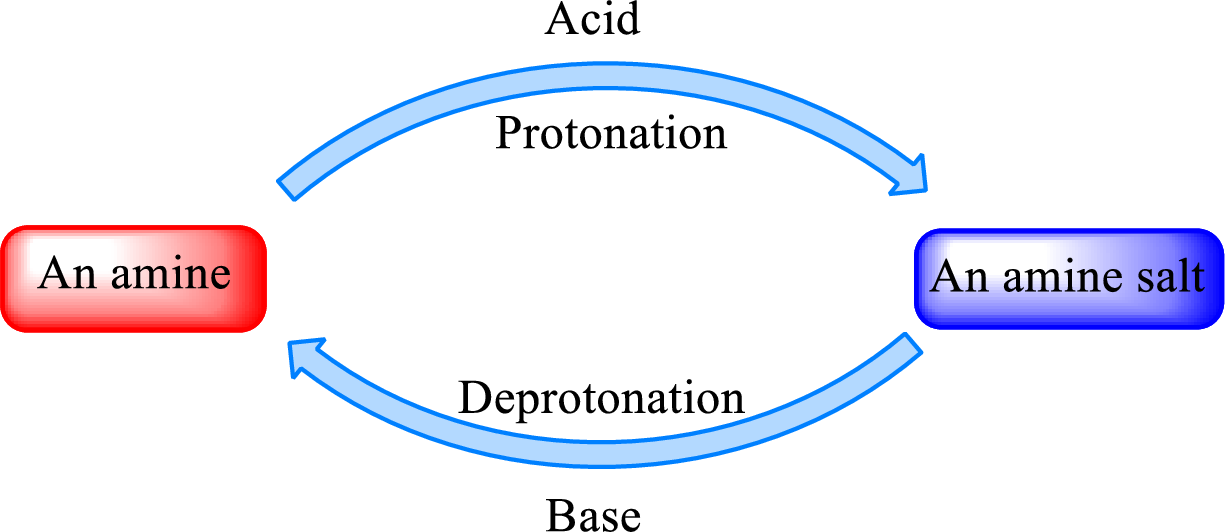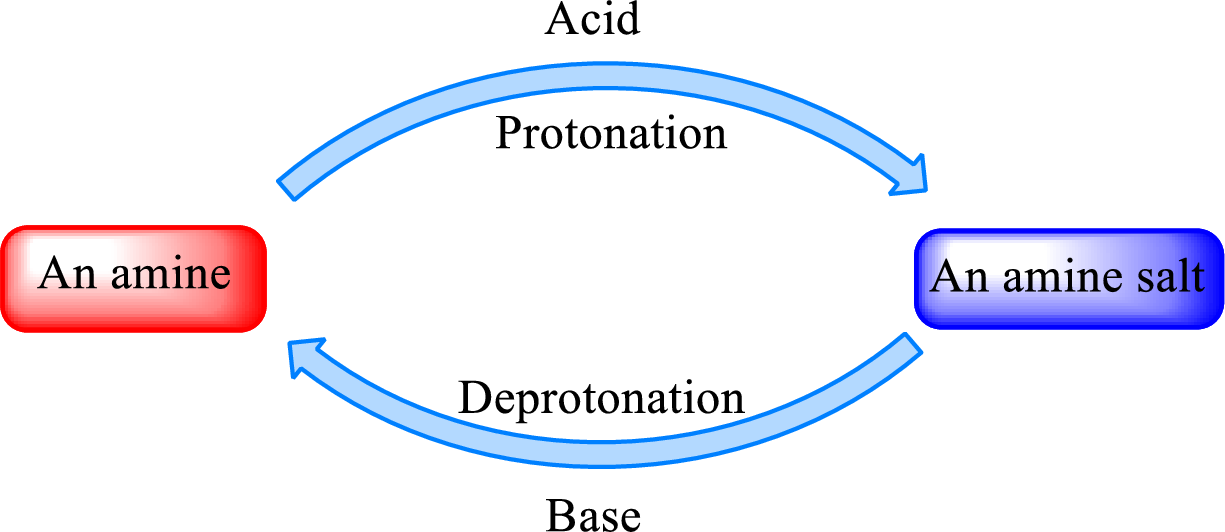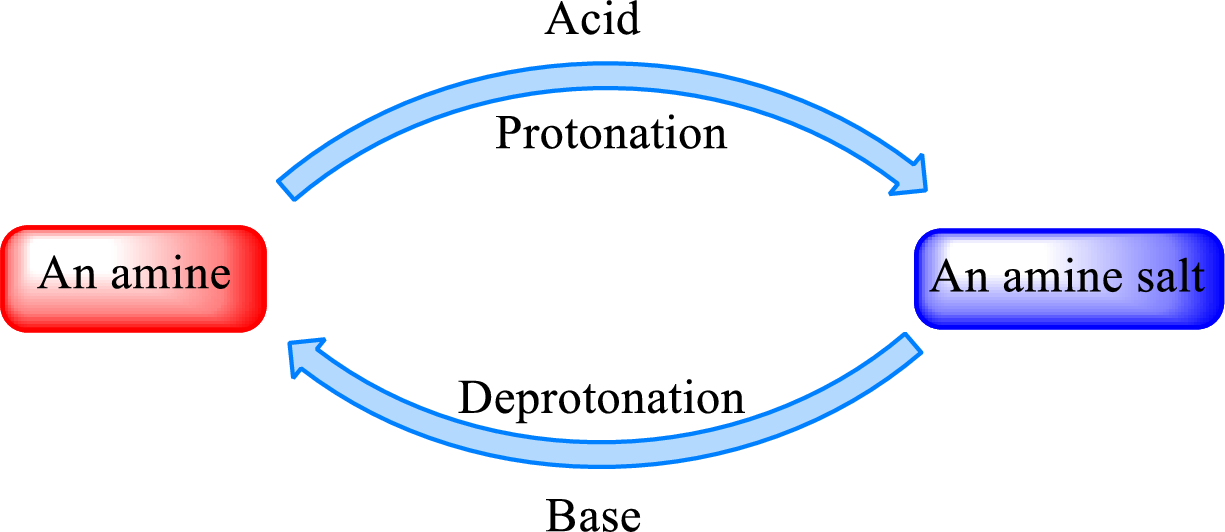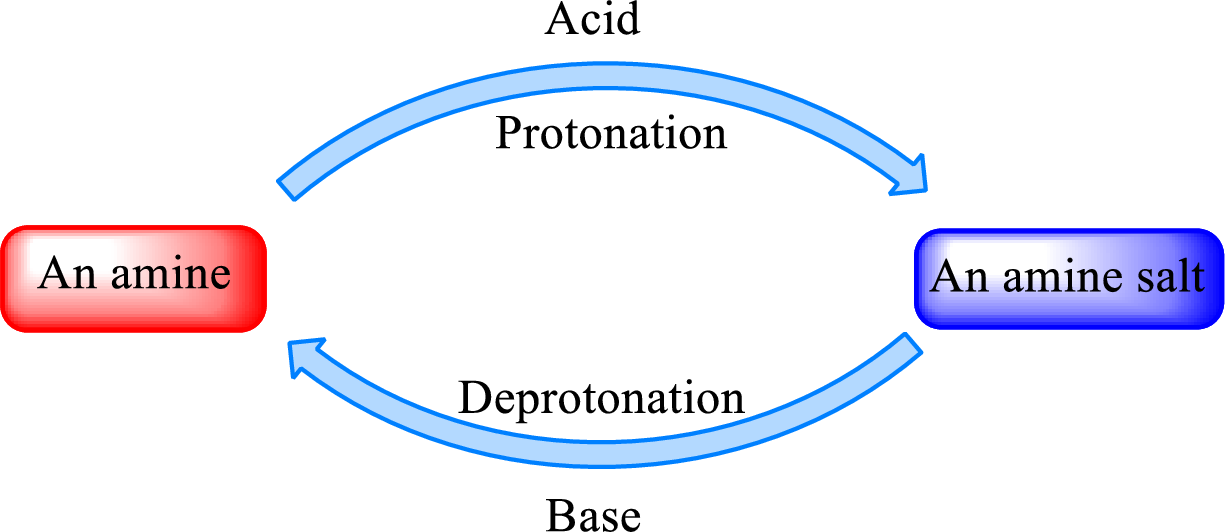
(a)
Interpretation:
Structure of amine that is formed when the given amine salt reacts with
Concept Introduction:
Neutralization reaction is the one that takes place between an acid and a base to give salt as product. As
When a strong base is added to the amine salt, the parent amine can be obtained. This is a reverse reaction of the amine salt formation reaction. These reactions can be represented as shown below,

(b)
Interpretation:
Structure of amine that is formed when the given amine salt reacts with
Concept Introduction:
Neutralization reaction is the one that takes place between an acid and a base to give salt as product. As amines are bases due to the amino group in it, the reaction with inorganic acid or carboxylic acid gives salt as product. The salt formed is an amine salt. Proton is donated from the acid to the nitrogen atom which acts as a proton acceptor. In simple words, it can be said that in an amine‑acid reaction, the acid loses a hydrogen ion and amine gains a hydrogen ion.
When a strong base is added to the amine salt, the parent amine can be obtained. This is a reverse reaction of the amine salt formation reaction. These reactions can be represented as shown below,

(c)
Interpretation:
Structure of amine that is formed when the given amine salt reacts with
Concept Introduction:
Neutralization reaction is the one that takes place between an acid and a base to give salt as product. As amines are bases due to the amino group in it, the reaction with inorganic acid or carboxylic acid gives salt as product. The salt formed is an amine salt. Proton is donated from the acid to the nitrogen atom which acts as a proton acceptor. In simple words, it can be said that in an amine‑acid reaction, the acid loses a hydrogen ion and amine gains a hydrogen ion.
When a strong base is added to the amine salt, the parent amine can be obtained. This is a reverse reaction of the amine salt formation reaction. These reactions can be represented as shown below,

(d)
Interpretation:
Structure of amine that is formed when the given amine salt reacts with
Concept Introduction:
Neutralization reaction is the one that takes place between an acid and a base to give salt as product. As amines are bases due to the amino group in it, the reaction with inorganic acid or carboxylic acid gives salt as product. The salt formed is an amine salt. Proton is donated from the acid to the nitrogen atom which acts as a proton acceptor. In simple words, it can be said that in an amine‑acid reaction, the acid loses a hydrogen ion and amine gains a hydrogen ion.
When a strong base is added to the amine salt, the parent amine can be obtained. This is a reverse reaction of the amine salt formation reaction. These reactions can be represented as shown below,

Want to see the full answer?
Check out a sample textbook solution
Chapter 17 Solutions
Study Guide with Selected Solutions for Stoker's General, Organic, and Biological Chemistry, 7th
- Synthesize N-Methylcyclohexylamine from cyclohexanol using the necessary organic or inorganic reagents. Draw the structures of the compounds.arrow_forwardSynthesize N-Methylcyclohexylamine from cyclohexanol using the necessary organic or inorganic reagents. Draw the structures of the compounds.arrow_forwardIf possible, please provide the formula of the compound 3,3-dimethylbut-2-enal.arrow_forward
- Synthesize 1,4-dibromobenzene from acetanilide (N-phenylacetamide) using the necessary organic or inorganic reagents. Draw the structures of the compounds.arrow_forwardIndicate the products obtained by mixing (3-oxo-3-phenylpropyl)triphenylphosphonium bromide with sodium hydride.arrow_forwardWe mix N-ethyl-2-hexanamine with excess methyl iodide and followed by heating with aqueous Ag2O. Indicate the major products obtained.arrow_forward
- Indicate the products obtained by mixing acetophenone with iodine and NaOH.arrow_forwardIndicate the products obtained by mixing 2-Propanone and ethyllithium and performing a subsequent acid hydrolysis.arrow_forwardIndicate the products obtained if (E)-2-butenal and 3-oxo-butanenitrile are mixed with sodium ethoxide in ethanol.arrow_forward
- Question 3 (4 points), Draw a full arrow-pushing mechanism for the following reaction Please draw all structures clearly. Note that this intramolecular cyclization is analogous to the mechanism for halohydrin formation. COH Br + HBr Brarrow_forwardIndicate the products obtained if 2,2-dimethylpropanal and acetaldehyde are mixed with sodium ethoxide in ethanol.arrow_forwardIndicate the products obtained if 2,2-dimethylpropanal and acetaldehyde are reacted with sodium ethoxide in ethanol.arrow_forward
 General, Organic, and Biological ChemistryChemistryISBN:9781285853918Author:H. Stephen StokerPublisher:Cengage Learning
General, Organic, and Biological ChemistryChemistryISBN:9781285853918Author:H. Stephen StokerPublisher:Cengage Learning Organic And Biological ChemistryChemistryISBN:9781305081079Author:STOKER, H. Stephen (howard Stephen)Publisher:Cengage Learning,
Organic And Biological ChemistryChemistryISBN:9781305081079Author:STOKER, H. Stephen (howard Stephen)Publisher:Cengage Learning, Introduction to General, Organic and BiochemistryChemistryISBN:9781285869759Author:Frederick A. Bettelheim, William H. Brown, Mary K. Campbell, Shawn O. Farrell, Omar TorresPublisher:Cengage Learning
Introduction to General, Organic and BiochemistryChemistryISBN:9781285869759Author:Frederick A. Bettelheim, William H. Brown, Mary K. Campbell, Shawn O. Farrell, Omar TorresPublisher:Cengage Learning Chemistry for Today: General, Organic, and Bioche...ChemistryISBN:9781305960060Author:Spencer L. Seager, Michael R. Slabaugh, Maren S. HansenPublisher:Cengage Learning
Chemistry for Today: General, Organic, and Bioche...ChemistryISBN:9781305960060Author:Spencer L. Seager, Michael R. Slabaugh, Maren S. HansenPublisher:Cengage Learning Chemistry & Chemical ReactivityChemistryISBN:9781337399074Author:John C. Kotz, Paul M. Treichel, John Townsend, David TreichelPublisher:Cengage Learning
Chemistry & Chemical ReactivityChemistryISBN:9781337399074Author:John C. Kotz, Paul M. Treichel, John Townsend, David TreichelPublisher:Cengage Learning Chemistry & Chemical ReactivityChemistryISBN:9781133949640Author:John C. Kotz, Paul M. Treichel, John Townsend, David TreichelPublisher:Cengage Learning
Chemistry & Chemical ReactivityChemistryISBN:9781133949640Author:John C. Kotz, Paul M. Treichel, John Townsend, David TreichelPublisher:Cengage Learning





